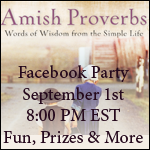Tissue Alert
Reviewed by Phee Paradise
Choosing to See
By Mary Beth Chapman with Ellen Vaughn
Warning: open a new box of tissues before you pick up Choosing to See by Mary Beth Chapman. It’s the heart rending story of the loss of her youngest daughter. Chapman tells the story with honesty, openly sharing her grief, love and even joy. You’ll start crying on the second page, where she describes her daughter’s death, but the story is not only about loss and you’ll laugh with her as well.
Mary Beth Chapman is the wife of well known Christian musical artist, Steven Curtis Chapman. The pain and loss that their family has experienced is probably well known among his fans, but Mary Beth tells it in a very personal way, bringing her reader into her circle of friends and family. After opening the book with a brief, but heart wrenching account of little Maria’s death, the author goes back to the beginning of the Chapman story. She tells us how she met Steven, how they struggled as he tried to break into the Christian music market, and how their family grew. She brings each member of the family, including their six children, to life so that the readers feels like we really know them.
This prepares us for the devastating loss of Maria, their youngest. When Steven had achieved success in his career and their three natural children were no longer babies, the Chapmans decided to adopt a child from China. This led to more adoptions, helping friends adopt and creating several adoption ministries. Maria was their third Chinese daughter. At age five, the Lord took her home under devastating circumstances. After describing her loss again and the family’s overwhelming grief, Chapman goes on to tell us how God helped them begin to heal. The book is a story of triumph, as well as grief, but even the healing will make you cry. Only two years since her loss, the author’s emotions are still raw, and the healing has only begun. But Chapman brings you alongside her, as if sharing herself with a close friend. It’s a wonderful gift.
After you have cried with Mary Beth, I know you will pray for her and you will also thank God for her amazing testimony.
Available September 2010 at your favorite bookseller from Revell, a division of Baker Publishing Group.
About the book From the beginning, Mary Beth Chapman's life was not how she planned. All she wanted was a calm, peaceful life of stability and control. Instead, God gave her an award-winning singer/songwriter husband, crazy schedules, and a houseful of creatively rambunctious children. Most difficult of all, God's plans for her also included tragedy.
From the beginning, Mary Beth Chapman's life was not how she planned. All she wanted was a calm, peaceful life of stability and control. Instead, God gave her an award-winning singer/songwriter husband, crazy schedules, and a houseful of creatively rambunctious children. Most difficult of all, God's plans for her also included tragedy.
In Choosing to SEE, Mary Beth unveils her struggle to allow God to write the story of her life, both the happy chapters and the tragic ones. And as the story unfolds, she's been forced to wrestle with some of life's biggest questions: Where is God when things fall apart? Why does God allow terrible things to happen? How can I survive hard times?
No matter where you find yourself in your own life story, you will treasure the way Mary Beth shows that even in the hard times, there is hope if you choose to SEE.
About the authors
Mary Beth Chapman is the wife of Grammy and Dove Award winning recording artist Steven Curtis Chapman. Together they began Show Hope, a nonprofit organization dedicated to caring for the world's most vulnerable children by providing financial assistance to families wishing to adopt, as well as increasing awareness of the orphan crisis and funneling resources to orphans domestically and internationally. Mary Beth serves as president of Show Hope and is a speaker for Women of Faith 2010 with her husband. She is also coauthor with Steven of the Shaoey and Dot series of children's picture books. Mary Beth and Steven have six children: Emily, Caleb, Will Franklin, and adopted daughters Shaohannah Hope, Stevey Joy, and Maria Sue, who is now with Jesus. The Chapmans live in Tennessee.
www.MaryBethChapman.com
Ellen Vaughn is a bestselling author and inspirational speaker. Her recent books include It's All About Him with Denise Jackson (wife of Alan Jackson), which debuted at #1 on the New York Times nonfiction list. She is also coauthor with Chuck Colson of Being the Body. In addition to her nonfiction work, Vaughn is an award-winning novelist. She lives in the Washington, D.C., area with her husband, Lee.




























































